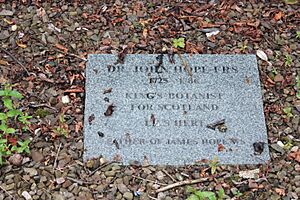John Hope (botanist) facts for kids
Quick facts for kids
John Hope
|
|
|---|---|
 |
|
| Born | 10 May 1725 Edinburgh
|
| Died | 10 November 1786 (aged 61) Edinburgh
|
| Nationality | Scottish |
| Alma mater | University of Edinburgh University of Paris |
| Children | Robert Hope, Marianne Hope, John Hope, Thomas Charles Hope, James Hope |
| Scientific career | |
| Fields | Botany, medicine |
| Institutions | President, Royal College of Physicians of Edinburgh (1784-1786) King's Botanist (1761-86) Professor of Botany, University of Edinburgh |
| Author abbrev. (botany) | Hope |
Professor John Hope (1725–1786) was an important Scottish doctor and botanist. He studied plants and how they grow. He is famous for supporting Carl Linnaeus's system for naming and grouping plants. This system is still used today.
John Hope helped start the Royal Society of Edinburgh in 1783. This is a famous group for scientists and thinkers. From 1784 to 1786, he was the president of the Royal College of Physicians of Edinburgh.
Contents
John Hope's Early Life and Education
John Hope was born in Edinburgh, Scotland, on May 10, 1725. His father, Robert Hope, was a surgeon.
He went to Dalkeith Grammar School for his early education. Later, he studied medicine at the University of Edinburgh. He also traveled to Paris to study botany, the science of plants. There, he learned from a famous botanist named Bernard de Jussieu.
In 1750, John Hope finished his medical studies. He earned his MD degree from the University of Glasgow.
A Career in Medicine and Botany
For about ten years, John Hope worked as a doctor. But he spent his free time studying plants. In 1760, he became the Professor of Botany at the University of Edinburgh. He also became the King's Botanist. This meant he was the official plant expert for the king.
John Hope loved botany so much that he wanted to focus only on it. He helped split his teaching job into two parts. He became the Professor of Medicine and Botany. A new role was created for teaching about medicines.
Developing the Royal Botanic Garden
In 1763, John Hope had a big idea. He wanted to combine two smaller plant gardens into one large, new garden. This new garden was built on Leith Walk in Edinburgh. It took several years to move all the plants. The old gardens closed in 1770.
One of the old gardens had been flooded and damaged. John Hope worked hard to get money for the new garden. This helped create what we now know as the Royal Botanic Garden Edinburgh. It was one of the first "Royal Botanic Gardens" to have lasting support.
Even though he didn't publish many books, John Hope did many experiments. He studied how plants work and grow. His discoveries helped his students learn a lot about botany. He became a member of the Royal Society in 1767. This is a very old and respected scientific group.
He lived in Edinburgh's Old Town later in his life. John Hope passed away in Edinburgh on November 10, 1786. He was buried at Greyfriars Kirkyard.
John Hope's Family Life
John Hope was married to Juliana Stevenson. Her brother, Dr. Alexander Stevenson, also helped start the Royal Society of Edinburgh.
John and Juliana Hope had several children:
- Robert Hope
- Marianne Hope
- Major John Hope
- Thomas Charles Hope
- James Hope
His grandson, John Hope, became a lawyer. He was known for helping others and started the Hope Trust.
Secondary sources
(digital edition in Internet Archive: one hour lending); new edition by Henri J. Noltie, 2011 ISBN: 9781906129712



